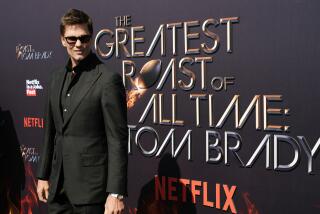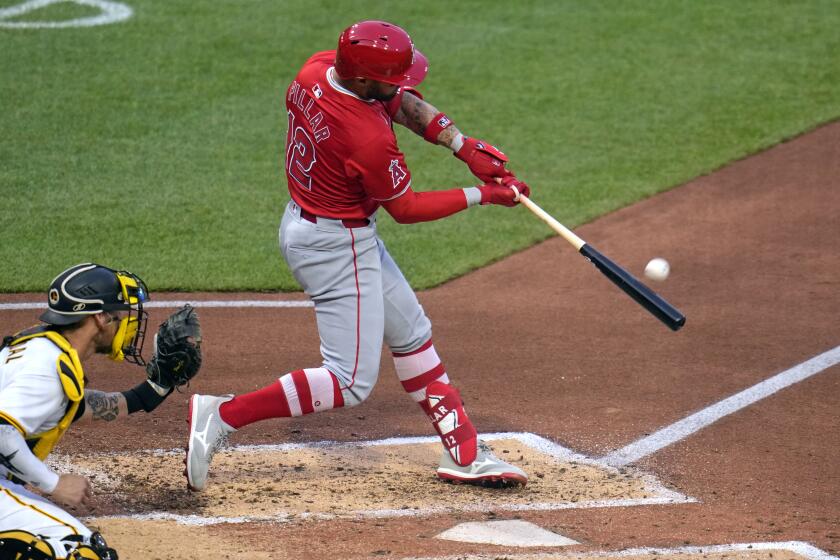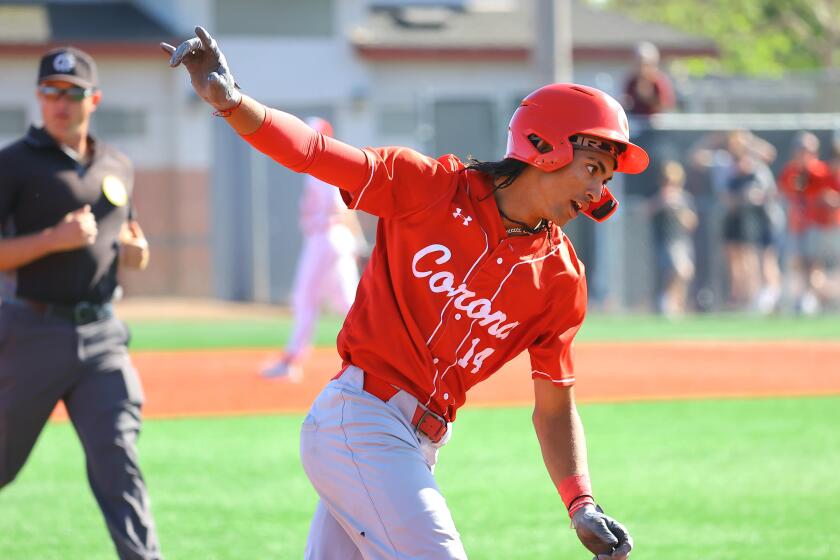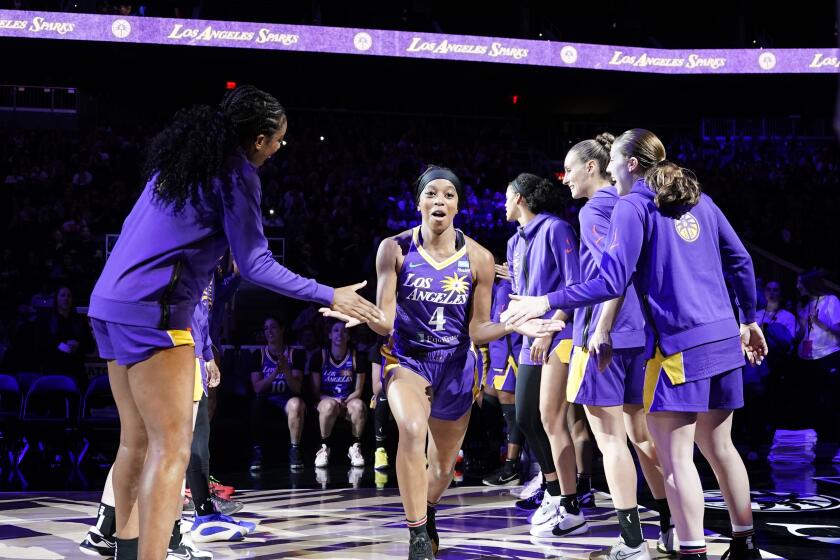The Nyet-Ready-for-Prime-Time Players
It’s mid-September in Moscow, and you’ve just seen a man standing on a square throw a bayonet at a lighthouse on the edge of the moon.
Who’s crazy?
Not John Lehr. He knows a well-turned relay when he sees it: an outfielder on the diamond making a hard peg to the cutoff man at the edge of the infield dirt.
That’s beizbol, comrade. And Lehr, a 39-year-old attorney and baseball fanatic from Laguna Beach, has become one of its most visible ambassadors, bringing gloves and glasnost and a bit of The Show to a land where the horsehide is still on the horses.
For 10 days in September, Lehr and a pair of retired major league veterans--former Angel pitcher Tom Murphy and former Dodger third baseman Ken McMullen--watched the most American of all games being played at Moscow University by the Soviet Union’s premier baseball team, the national champion Moscow Red Devils.
And after each game, Murphy and McMullen took the field with the players to coach them in the finer points of the game that most of them had taken up only four years ago after the International Olympic Committee voted to make baseball an Olympic medal sport.
The trip, said Lehr, was primarily a goodwill journey “using baseball as the vehicle. Baseball was really an extension of personal involvement with the people there. It brings a smile to people’s faces. It breaks the ice.”
Lehr’s group, traveling under the name Baseball Ambassadors (“Bases for Understanding” is its motto), was the result of Lehr’s passion not only for baseball, but for travel and cultural exchange. Before setting up the September visit, he had gone along last year on baseball/goodwill trips to Nicaragua and the Soviet Union that were arranged by other international sports organizations.
Particularly taken by the idea of helping the game gain a stronger foothold in the Soviet Union, Lehr said he decided to assemble his own tour--which cost him about $5,000--that would expose the best team in the country to instruction from experienced major leaguers while, in the bargain, learning lessons about Life and Baseball, Russian style.
Lesson No. 1: It hasn’t replaced hockey. Yet.
Nobody in the Soviet Union knows anything about baseball, said Lehr, except the players and their families and friends. That’s the bad news. The good news is that those in the know have embraced the game.
“People would see us traipsing around our hotel in our uniforms,” he said, “but I don’t think they know the game of baseball even exists. But the players are fanatics. They’re very thirsty for knowledge about American baseball stars.
“You’ll see copies of Sports Illustrated from two years ago lying around. They seem to embrace players with colorful nicknames: Dave Parker is The Cobra, Andre Dawson is The Hammer. They love them. And any time they can get their hands on American baseball memorabilia and clothing items, they’re very enthusiastic.”
The American trio provided. To the Red Devils went seven aluminum bats, a fungo bat, 24 baseballs, 10 gloves and six pairs of spikes, all items that are, for the most part, not home-grown in the Soviet Union.
That could change. Lehr said that the players told him that the failure of the coup could mean that Soviet aluminum could now be used for bats instead of tanks.
More than equipment, however, the players craved knowledge. Murphy’s and McMullen’s brains got thoroughly picked.
“They reacted very warmly to Tom and Ken because of their reputation and credentials,” said Lehr, “and many of them stayed after (the clinics) asking questions. It was like a fantasy camp for those guys. They’d come by our hotel afterward and just want to talk about baseball.”
Murphy was impressed.
“They were far more advanced than I thought,” said Murphy, who lives in San Juan Capistrano and works for a real estate brokerage. “All the pitchers could throw sliders and some had split-finger fastballs. I was surprised that they were so interested and soaked up the knowledge so fast. They treated us kind of like gurus. They were in awe, and you could see it when Ken and I were warming up. We played a lot of pepper and they just stood around and watched how we conducted ourselves.”
They were almost the only ones watching, however.
“There are no crowds,” Lehr said. “It’s a lot like going to a Little League game where the parents come and keep score for their kids. You see that there, too. It’s a very warm, middle-America kind of approach.”
Lesson No. 2: Can’t anybody here play this game? Yes. Sort of.
How good are they? Lehr and Murphy said they compare favorably to a good American high school or junior college team. They are, after all, the Soviet Union’s best, and 12 of the players are on the national team. Last year the Red Devils won the European Division B championships, which qualified them to compete in the Division A, or Olympic-class, bracket.
They have played in Japan and in the United States, and within the Soviet Union, they compete with other teams of the fledgling Soviet Baseball Federation. During Lehr’s visit, their opponent was the team from Odessa, near the Black Sea. They won all three games against Odessa by a combined score of 44 to 4.
They are consistent winners and, said Lehr, they look the part.
“They’re a very sharply disciplined unit,” said Lehr, “and since they came back from Japan, where Mizuno gave them equipment, they look top quality. Other teams have a variety of haphazard dress, but they have good-looking uniforms.
“Also, they emulate the mannerisms of American players. One detrimental thing they picked up, though, is chewing tobacco.”
The Red Devils are full-time, paid professional athletes, said Lehr, and some of them have been making their living that way for some time.
“The way they formed the first teams,” said Lehr, “was to draw athletes from other sports. Javelin throwers became pitchers and outfielders because of their strong arms. Tennis players became infielders because of their good foot movement and hand-eye coordination. Hockey goalies became first basemen.”
The missing element: a feel for nuance.
“There’s chatter in the infield, there’s enthusiasm, but you don’t see the loose movements that American kids learn from a very early age,” Lehr said. “They’re more mechanical.”
Throwing motions, especially among pitchers, often look artificial or contrived, he said. And Murphy discovered a certain lack of appreciation for strategy.
“The pitchers don’t have a feel for some of the intricacies,” said Murphy, “like holding runners on base and setting hitters up. And they concentrated more on breaking balls than on developing good fastballs. When they got behind in the count, they were throwing a lot of breaking balls.”
And, even though the Red Devils play on the most sophisticated--and only--baseball field in the Soviet Union, their ball yard often is less than stunning. Which brings us to:
Lesson No. 3: The Metrodome it ain’t.
The Red Devils practice and play their home games on a 3-year-old artificial turf field at Moscow University. Financed by $3.5 million worth of Japanese funds and built by a Yugoslav construction firm, it’s the best field in the country. Which, by American baseball standards, isn’t saying much.
“In getting to know the baseball program, you can learn a lot about Russian culture,” said Lehr, “starting with the baseball field. You wouldn’t think an artificial surface field would need much maintenance, but apparently they don’t have the money or the manpower or the inclination to maintain the cutout dirt areas of the infield. When it rains regularly, you end up with puddles on the dirt and on the carpet. They have whisk brooms made of twigs to sweep the water away and makeshift shovels and slats of wood to move the dirt.”
The pitcher’s mound is so loosely packed, said Lehr, the pitchers have difficulty pushing off of it effectively and consequently have developed strange and awkward sidearm-like pitching motions.
But, compared with the fields used by other teams, it’s a palace. Baseball elsewhere in the country is routinely played on soccer fields with ankle-deep grass.
Adaptations have been made. The Soviet Red Army team’s home field, said Lehr, has its own version of Fenway Park’s “Green Monster.” To extend the right field fence, the team hung up large camouflage nets that are normally used for the protection of tanks and bunkers.
Lesson No. 4: Enthusiasm, 10; instincts, 4.
Soviet baseball is played with a verve and, uh, creativity that is seldom seen elsewhere. A few plays for the highlight films, culled from Lehr’s trip diary, include:
* A catcher, frustrated with the wildness of his pitcher, resorted to stuffing the ball in his chest protector, pretending a wild pitch had occurred, and tagging the runner attempting to score from third base.
* A pitcher having control problems suggested changing places with his catcher, who was failing in his attempts to throw out runners at second base. The catcher did.
* A catcher, attempting to foil a sacrifice bunt, ran around the hitter and caught the pitch in front of the plate.
“They asked me what the umpire’s ruling should be,” Murphy said. “That situation would never happen in the United States. It was completely off the wall.”
* “An outfielder misjudged a fly ball so badly that it conked him on the head,” said Lehr, “then it ricocheted to the first baseman, who caught it for the out.”
* An umpire, hit by a pitch the catcher couldn’t handle, declared a “hit by pitch” situation and switched places with the first-base umpire.
Lesson No. 5: Buddy it up with the umpire.
Umpires, said Lehr, seldom have to contend with Billy Martin-like volatility on the part of players or coaches. However, he said, “I’ve heard of great arguments that take place--which is typically American--but with the Soviet touch they can take place two or three games after the event has happened. Nothing would happen at the point of controversy, but later the manager would go out and argue with the umpire over something that would have occurred long before.”
Soviet umpires are few and, on the field, are still rather rigid and colorless compared with the antic behavior of, say, a Ron Luciano. But they, too, have come down with a case of baseball fever.
“We met a gentleman named Mischa,” said Lehr, “who formed the first Soviet umpire training school. He was a cabdriver. We didn’t know whether he was moonlighting as an umpire or a cabbie, but he ended up driving us around. We were chauffeured around Moscow for an evening courtesy of the local umpire.”
The trio also was brought home to dinner by some of the players, where they exchanged food, drink and baseball stories in halting English and Russian, punctuated by a lot of gesturing. The communication gap, said Murphy, “was easily overcome because baseball is such a visionary kind of game where verbal communication is not quite as necessary.”
Still, said Lehr, smiling, “there’s a little legacy that needs to be created before they can tell a story on a competitive level.”
Lesson No. 6: It’s still a kid’s game.
If Murphy and McMullen were heroes to the Red Devils, the Soviet players have become the heroes of a growing number of baseball-crazy Russian kids.
Before Lehr’s delegation left for home, they attended a game in Moscow between two teams of 14-year-olds, a T-ball game for 8- and 9-year-olds and conducted a clinic for 9- to 11-year olds.
Today, said Lehr, there are nearly 50 youth baseball teams in the Moscow area and several others in St. Petersburg, Kiev and Tashkent. The first National Youth Championships were held this year, with 12 teams competing.
And Lehr said that Sergei Kurchenko, head of the Moskvich Youth Baseball program in Moscow, reported that no fewer than 30 children a day are asking to join his baseball programs.
Lehr, Murphy and McMullen fanned the enthusiasm with gifts of 70 gloves, six aluminum bats, 24 baseballs and a collection of Dodger and Angel souvenirs and Major League baseball highlight videos.
“Those kids are the pioneers,” Lehr said. “They’ll be the first real generation of Soviet baseball.”
And, if Lehr was convincing, they’ll be able to grow up with the great Little League tradition of the postgame feast.
Before Lehr left for home, he urged the Red Devils to try to strike a deal with McDonald’s and Pizza Hut to build franchises adjacent to the Moscow baseball field. His reasoning: Because of the wild popularity of the two restaurants already in Moscow (there is, he said, a routine two-hour lunchtime wait at the local McDonald’s, even with its 43 cash registers), establishing franchises near the ballpark would be a draw for crowds who might become curious and sit down in the stands to finish their Big Macs and pizzas.
“If they build it,” he said, “they will come.”
More to Read
Get our high school sports newsletter
Prep Rally is devoted to the SoCal high school sports experience, bringing you scores, stories and a behind-the-scenes look at what makes prep sports so popular.
You may occasionally receive promotional content from the Los Angeles Times.






